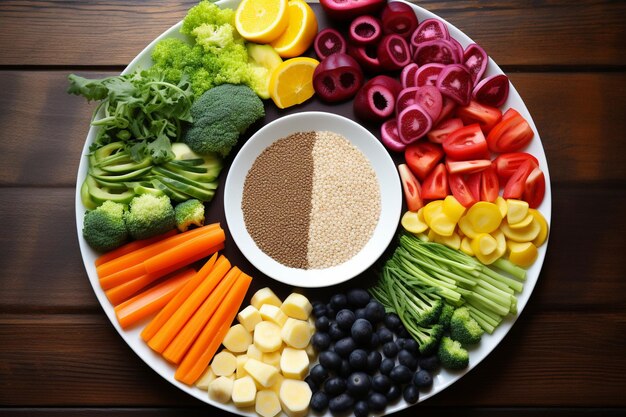Lose 10 Pounds in 30 Days: Your Nutrition and Cardio Plan

Lose 10 pounds in 30 days by combining a strategic nutrition plan with effective cardio workouts. This guide provides a comprehensive approach to help you achieve your weight loss goals in a healthy and sustainable manner, focusing on nutrition and exercise.
Ready to shed those extra pounds and feel amazing in just 30 days? It’s a common goal, but many find it challenging to achieve. This guide provides a clear and actionable plan to help you lose 10 pounds in 30 days through a combination of smart nutrition and effective cardio exercises.
We’ll break down the essential steps, offering practical tips and advice to keep you motivated and on track toward achieving your weight loss goals. Get ready to transform your body and your health!
The Science Behind Losing 10 Pounds in 30 Days
Understanding the science behind weight loss is crucial to achieving sustainable results. Losing weight effectively involves creating a calorie deficit, where you burn more calories than you consume. This section will explain the principles behind calorie deficits and how they can help you lose weight safely and efficiently.
Understanding Calorie Deficits
To lose weight, you need to burn more calories than you consume. This is known as creating a calorie deficit. A deficit of 500 to 750 calories per day can lead to a weight loss of about 1 to 2 pounds per week, which is considered a healthy and sustainable rate. It’s essential to calculate your Basal Metabolic Rate (BMR) and activity level to determine your daily calorie needs.
The Role of Macronutrients
Macronutrients—proteins, carbohydrates, and fats—play essential roles in weight loss. Protein helps maintain muscle mass, which is crucial for burning calories. Carbohydrates provide energy, and healthy fats support hormone production and overall health. Balancing these macronutrients is vital for a successful weight loss journey.
- Prioritize protein at each meal to boost satiety and maintain muscle mass.
- Choose complex carbohydrates like whole grains and vegetables for sustained energy.
- Incorporate healthy fats from sources like avocados, nuts, and olive oil.
By understanding the science behind weight loss and the roles of calories and macronutrients, you can create a sustainable plan to lose 10 pounds in 30 days.

Creating a Nutrition Plan to Lose Weight
A well-structured nutrition plan is the foundation of any successful weight loss journey. This section will guide you through creating a nutrition plan that is both effective and sustainable for helping you lose 10 pounds in 30 days.
Calculating Your Daily Calorie Needs
To start, determine your daily calorie needs. This involves calculating your Basal Metabolic Rate (BMR), which is the number of calories your body burns at rest. Use an online calculator or consult with a nutritionist to get an accurate estimate. Then, factor in your activity level to determine your total daily calorie needs. Finally, create a calorie deficit of 500 to 750 calories per day to promote weight loss.
Sample Meal Plans
Having a sample meal plan can make it easier to stick to your nutrition goals. Here’s a sample plan to help guide you:
- Breakfast: Oatmeal with berries and nuts
- Lunch: Grilled chicken salad with mixed greens and a light vinaigrette
- Dinner: Baked salmon with steamed vegetables and quinoa
- Snacks: Greek yogurt, a handful of almonds, or a piece of fruit
Remember to adjust portion sizes to fit your calorie needs and preferences. Staying consistent with your meal plan can greatly increase your chances of effectively losing weight.
Effective Cardio Workouts for Fat Loss
Cardio workouts are essential for burning calories and promoting weight loss. This section will outline the most effective cardio exercises to incorporate into your routine to help you
High-Intensity Interval Training (HIIT)
HIIT involves short bursts of intense exercise followed by periods of rest or low-intensity exercise. This type of workout is highly effective for burning calories and fat in a short amount of time. You can do HIIT with exercises like sprinting, burpees, or jump squats.
Moderate-Intensity Steady State (MISS) Cardio
MISS cardio involves maintaining a moderate intensity for a longer period. Examples include jogging and power walking. This type of exercise is great for building endurance and burning calories over an extended duration.

- Aim for at least 30 minutes of HIIT or MISS cardio most days of the week.
- Vary your workouts to avoid boredom and prevent plateaus.
- Listen to your body and adjust intensity as needed.
Combining HIIT and MISS cardio can provide a well-rounded approach to fat loss, helping you to efficiently lose those extra pounds. The integration of regular cardio workouts into your plan provides an excellent way to boost your metabolism.
The Importance of Strength Training
While nutrition and cardio are crucial, strength training plays a significant role in losing weight. Building muscle mass can boost your metabolism and help you burn more calories even when you’re at rest. This section will emphasize the value of strength training in conjunction with diet and cardio.
Benefits of Strength Training
Strength training helps you maintain and build muscle mass, which is essential for boosting your metabolism. More muscle mass means you burn more calories at rest, making it easier to create a calorie deficit. In addition, strength training can improve your overall body composition and strength.
Sample Strength Training Exercises
Consider incorporating these exercises into your routine:
- Squats
- Lunges
- Push-ups
- Dumbbell rows
Aim to do strength training exercises at least two to three times per week, targeting all major muscle groups. With consistency, the integration of strength training provides an important element to weight loss.
Tracking Your Progress and Staying Motivated
Tracking your progress and staying motivated are key components of a successful weight loss journey. This section will provide tips on how to monitor your progress, set realistic goals, and maintain motivation to achieve your desired weight.
Methods for Tracking Progress
There are several ways to track your progress:
- Weigh yourself regularly (e.g., once per week)
- Take body measurements (e.g., waist, hips)
- Take progress photos
- Keep a food journal to monitor your calorie intake
Tips for Staying Motivated
Staying motivated can be challenging, but here are some helpful tips:
- Set realistic goals and celebrate small victories.
- Find a workout buddy for support and accountability.
- Reward yourself for milestones achieved (e.g., with non-food-related treats).
- Stay consistent with your nutrition and exercise plan, even on challenging days.
Lose 10 Pounds in 30 Days: The Ultimate Nutrition and Cardio Plan involves tracking progress meticulously to stay motivated in your weight loss journey.
| Key Point | Brief Description |
|---|---|
| 💪 Calorie Deficit | Burn more calories than you consume. |
| 🍎 Nutrition Plan | Balanced macronutrients and controlled calorie intake. |
| 🏃 Cardio Workouts | HIIT and steady-state cardio for fat loss. |
| 🏋️ Strength Training | Build muscle to increase metabolism. |
Frequently Asked Questions
To safely lose 10 pounds in 30 days, focus on creating a calorie deficit through a balanced diet and regular exercise. Consult with a healthcare professional or nutritionist for personalized advice.
Avoid processed foods, sugary drinks, and excessive amounts of unhealthy fats. These foods are often high in calories and low in essential nutrients, hindering your weight loss efforts.
Aim for at least 150 minutes of moderate-intensity or 75 minutes of high-intensity cardio per week. Mix it up with activities you enjoy to stay consistent and burn calories.
Yes, strength training helps build muscle mass, which boosts your metabolism and helps you burn more calories even at rest, making it an important part of a weight loss plan.
Set realistic goals, track your progress, find a workout buddy, and reward yourself for milestones achieved. Staying consistent and celebrating small victories can keep you motivated.
Conclusion
Following a structured nutrition and cardio plan can help you lose 10 pounds in 30 days. By understanding the science behind weight loss, implementing effective workouts, and tracking your progress, you can achieve your goals and maintain a healthy lifestyle.





